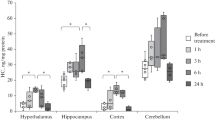Abstract
During pregnancy, several complications have been associated with hyperhomocysteinemia (HHcy) and elevated homocysteine (Hcy) levels have been shown to play a role in the etiology of preeclampsia, placental abruption, intrauterine growth retardation, and neural tube defects and associated with the neurological consequences. In the present work, we investigated the effects of chronic maternal HHcy on the development and neurobehavioral maturation of the offspring. We analyzed classical parameters of development such as body weight, eyelid opening, ear unfolding, incisor eruption, and the appearance of hair, and subjected the pups to various tests that reflected the neurobehavioral maturation extending from 4th to 20th postnatal days (righting reflex, negative geotaxis, cliff avoidance, head shake, acoustic startle reflex, free-fall righting, cliff avoidance caused by visual stimulus, olfactory discrimination). We have shown that newborn animals were characterized by lower body weight and higher mortality. Besides, the delay in neurobehavioral maturation of the pups from the Hcy group was observed. The obtained results indicate that early developmental impairments of brain maturation induced by prenatal HHcy may underlie long-term deficits in the learning and memory behaviors.

Similar content being viewed by others
References
Hague, W. M. (2003). Homocysteine and pregnancy. Best Practice & Research. Clinical Obstetrics & Gynaecology, 17, 459–469.
Takimoto, H., Mito, N., Umegaki, K., Ishiwaki, A., Kusama, K., Abe, S., et al. (2003). Relationship between dietary folate intakes, maternal plasma total homocysteine and B-vitamins during pregnancy and fetal growth in Japan. European Journal of Nutrition, 46(5), 300–306.
Troen, A. M. (2005). The central nervous system in animal models of hyperhomocysteinemia. Progress in Neuro-Psychopharmacology and Biological Psychiatry, 29(7), 1140–1151.
Baydas, G., Koz, S. T., Tuzcu, M., Nedzvetsky, V. S., Etem, E. (2007). Effects of maternal hyperhomocysteinemia induced by high methionine diet on the learning and memory performance in offspring Int. International Journal of Developmental Neuroscience, 25, 133–139.
Blaise, S. A., Nédélec, E., Schroeder, H., Alberto, J. M., Bossenmeyer-Pourié, C., Guéant, J. L., et al. (2007). Gestational vitamin B deficiency leads to homocysteine-associated brain apoptosis and alters neurobehavioral development in rats. The American Journal of Pathology, 170(2), 667–679.
Arutjunyan, A., Kozina, L., Stvolinskiy, S., Ye, B., Mashkina, A., Khavinson, V. (2012). Pineal on protects the rat offspring from prenatal hyperhomocysteinemia. International Journal of Clinical and Experimental Medicine, 5(2), 179–185.
Wang, J., Ge, J., Yang, L., Zhang, H., Li, X., Xue, D. (2012). Brain cell apoptosis and enhancement of nervous excitability in pregnant rats with high plasma levels of homocysteine. Neural Regeneration Research, 7(28), 2199–2205.
Bełtowski, J., Wójcicka, G., Wojtak, A. (2012). Effect of experimental hyperhomocysteinemia on plasma lipid profile, insulin sensitivity and paraoxonase 1 in the rat. Adipobiology., 4, 77–84.
Lee, P. T., Lowinsohn, D., Compton, R. G. (2014). Simultaneous detection of homocysteine and cysteine in the presence of ascorbic acid and glutathione using a nanocarbon modified electrode. Electroanalysis, 26, 1488–1496.
Smart, J. L., & Dobbing, J. (1971). Vulnerability of developing brain. VI relative effects of fetal and early postnatal undernutrition on reflex ontogeny and development of behavior in the rat. Brain Research, 33, 303–314.
Deiró, T. C., Manhães-de-Castro, R., Cabral-Filho, J. E., Barreto-Medeiros, J. M., Souza, S. L., Marinho, S. M., et al. (2006). Sertraline delays the somatic growth and reflex ontogeny in neonate rats. Physiology and Behavior, 87(2), 338–344.
Kiss, P., Vadasz, G., Kiss-Illes, B., Horvath, G., Tamas, A., Reglodi, D., et al. (2013). Enviromental enrichment decreases asphyxia-induced neurobehavioral developmental delay in neonatal rats. International Journal of Molecular, 13, 22258–22273.
Dobbing, J., & Sands, J. (1973). Quantitative growth and development of human brain. Archives of Disease in Childhood, 48(10), 757–767.
Boldyrev, A. A. (2009). Molecular mechanisms of homocysteine toxicity. Biochemistry (Moscow), 74, 589–598.
Makhro, A. V., Mashkina, A. P., Solenaya, O. A., Trunova, O. A., Kozina, L. S., Arutyunian, A. V., et al. (2013). Prenatal hyperhomocysteinemia as a model of oxidative stress of the brain skeletal muscle malfunction. International Journal of Molecular Sciences, 14, 15074–15091.
Bukharaeva, E., Shakirzyanova, A., Khuzakhmetova, V., Sitdikova, G., Giniatullin, R. (2015). Homocysteine aggravates ROS-induced depression of transmitter release from motor nerve terminals: potential mechanism of peripheral impairment in motor neuron diseases associated with hyperhomocysteinemia. Frontiers in Cellular Neuroscience, 9, 391.
Gaifullina, A. S., Yakovlev, A. V., Mustafina, A. N., Weiger, T. M., Hermann, A., Sitdikova, G. F. (2016). Homocysteine augments BK channel activity and decreases exocytosis of secretory granules in rat GH3 cells. FEBS Letter. doi:10.1002/1873-3468.12381.
Acknowledgments
This work was supported by Russian Science Foundation no. 14-15-00618.
Author information
Authors and Affiliations
Corresponding author
Additional information
Elena Gerasimova contributed equally to this work.
Rights and permissions
About this article
Cite this article
Gerasimova, E., Yakovleva, O., Burkhanova, G. et al. Effects of Maternal Hyperhomocysteinemia on the Early Physical Development and Neurobehavioral Maturation of Rat Offspring. BioNanoSci. 7, 155–158 (2017). https://doi.org/10.1007/s12668-016-0326-6
Published:
Issue Date:
DOI: https://doi.org/10.1007/s12668-016-0326-6




